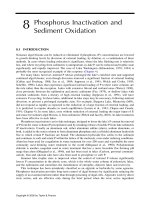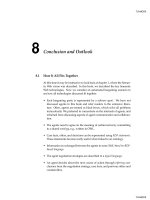Lecture management a pacific rim focus chapter 8 fostering an innovative organisation
Bạn đang xem bản rút gọn của tài liệu. Xem và tải ngay bản đầy đủ của tài liệu tại đây (410.39 KB, 21 trang )
CHAPTER 8
FOSTERING AN INNOVATIVE
ORGANISATION
© 2003 McGraw-Hill Australia Pty Ltd. PowerPoint
1
Lecture outline
•
•
•
•
The nature of change & innovation
Organisation life-cycles
Promoting innovation
Key organisational change components
© 2003 McGraw-Hill Australia Pty Ltd. PowerPoint
2
Nature of change & innovation
Change
Innovation
Any alteration of the
status quo.
New idea applied to
initiating or improving a
process, product or
service.
© 2003 McGraw-Hill Australia Pty Ltd. PowerPoint
3
Nature of change & innovation
Forces for change & innovation:
External:
External:Response
Responsetotoopportunities
opportunities
and
andthreats
threatsfrom
fromthe
themarket,
market,regulators
regulators
and
andother
otherelements
elementsofofthe
theenvironment
environment
Internal:
Internal:Strategy
Strategy&&plans,
plans,employees’
employees’
behaviour,
behaviour,change
change&&innovation
innovationdecisions,
decisions,
cultural
culturalchange,
change,restructures,
restructures,
technological
technological&&leadership
leadershipchange
change
© 2003 McGraw-Hill Australia Pty Ltd. PowerPoint
4
Organisational life cycles
Life cycles:
Predictable stages of development organisations
typically follow.
© 2003 McGraw-Hill Australia Pty Ltd. PowerPoint
5
Organisational life cycles
Intrepreneurial
Intrepreneurialstage
stage
Collectivity
Collectivitystage
stage
Formalisation
Formalisationand
andcontrol
controlstage
stage
Elaboration
Elaborationof
ofstructure
structurestage
stage
© 2003 McGraw-Hill Australia Pty Ltd. PowerPoint
6
Organisational life cycles
Methods of organisational termination:
• Bankruptcy
• Liquidation
• Merger
• Acquisition
• Take-over
© 2003 McGraw-Hill Australia Pty Ltd. PowerPoint
7
Promoting innovation
Recognition
Recognitionof
ofopportunity
opportunity
or
oraaproblem
problem
Line
Lineup
uppowerful
powerfulsponsors
sponsors
Develop
Developand
andcommunicate
communicate
aavision
vision
Empower
Empowerothers
othersto
to
act
actout
outthe
thevision
vision
Prepare
Prepareto
toovercome
overcomeresistance
resistance
Plan
Planfor
for&&reward
rewardvisible
visibleprogress
progress
Consolidate
Consolidateimprovements
improvements&&
facilitate
facilitatefurther
furtherchange
change
Monitor
Monitor&&institutionalise
institutionalisechange
change
© 2003 McGraw-Hill Australia Pty Ltd. PowerPoint
8
Promoting innovation
•
•
•
•
Organisational development
Innovation for competitive advantage
Product development
Intrepreneurship
© 2003 McGraw-Hill Australia Pty Ltd. PowerPoint
9
Promoting innovation
Organisational development
Diagnosis
Diagnosis
Intervention;
Intervention;44 techniques
techniques
••Process
Processconsultation
consultation
••Team
Teambuilding
building
••Third
Thirdparty
partyintervention
intervention
••Technostructural
Technostructuralactivities
activities
Evaluation
Evaluation
© 2003 McGraw-Hill Australia Pty Ltd. PowerPoint
10
Promoting innovation
Innovation for competitive advantage:
1)1)Hard
Hardfor
forcompetitors
competitorstotoimitate
imitate
Four
Fourfactors
factors
needed
neededto
to
ensure
ensure
advantage
advantage
2)2)Meeting
Meetingsignificant
significantcustomer
customerneeds
needs
3)3)Fit
Fitofofinnovation
innovationtotoorganisation’s
organisation’stime
time
advantages
advantages
4)4)Innovation
Innovationneeds
needstotorely
relyon
oncapabilities
capabilities
accessible
accessibletotothe
theorganisation,
organisation,but
butless
lessso
so
totocompetitors
competitors
© 2003 McGraw-Hill Australia Pty Ltd. PowerPoint
11
Promoting innovation
Product development principles:
• Establish a stage-gate development funnel
• Establish cross-functional teams
• Use concurrent engineering
• Involve both customers & suppliers
© 2003 McGraw-Hill Australia Pty Ltd. PowerPoint
12
Promoting innovation
Intrepreneurship:
Encourage the take-up of entrepreneurship roles by
organisation members e.g:
• Idea generator
• Idea champion
• Idea sponsor
• Idea orchestrator.
© 2003 McGraw-Hill Australia Pty Ltd. PowerPoint
13
Organisational change
components
•
•
•
•
•
Structural
Technological
Human resource
Cultural
Component inter-relationship
© 2003 McGraw-Hill Australia Pty Ltd. PowerPoint
14
Organisational change
components
Structural component:
• Job definitions
• Job groupings
• Teams
• Delegation
• Reporting relationships
© 2003 McGraw-Hill Australia Pty Ltd. PowerPoint
15
Organisational change
components
Technological component:
Technology may drive change/innovation by:
• Requiring new work methods.
• Providing/removing competitive edge.
© 2003 McGraw-Hill Australia Pty Ltd. PowerPoint
16
Organisational change
components
Human resources is the vehicle for changing
knowledge, skills, perceptions & behaviours
needed for a job. It utilises:
• Recruitment & selection
• Training
• Performance appraisal
• Reward systems.
© 2003 McGraw-Hill Australia Pty Ltd. PowerPoint
17
Organisational change
components
Major organisational changes often require
concomitant changes to organisational culture.
‘Organisational culture can be defined as a system
of shared values, assumptions, beliefs and norms
linking an organisation’s members.’
© 2003 McGraw-Hill Australia Pty Ltd. PowerPoint
18
Organisational change
components
Inter-relationship amongst components:
Change to one component creates tensions on
other components until they are adjusted accordingly.
• Minor change
May relate to only one component.
• Major change
May relate to all four components.
© 2003 McGraw-Hill Australia Pty Ltd. PowerPoint
19
Lecture summary
• Nature of change & innovation
– Distinguishing change from innovation.
– External & internal forces for change &
innovation.
• Organisation life cycles
– Life cycle stages.
– Termination.
© 2003 McGraw-Hill Australia Pty Ltd. PowerPoint
20
Lecture summary
• Promoting innovation
– Organisational development (OD)
– Innovation for competitive advantage
– Product development
– Entrepreneurship
• Organisational change
– Key components
© 2003 McGraw-Hill Australia Pty Ltd. PowerPoint
21









